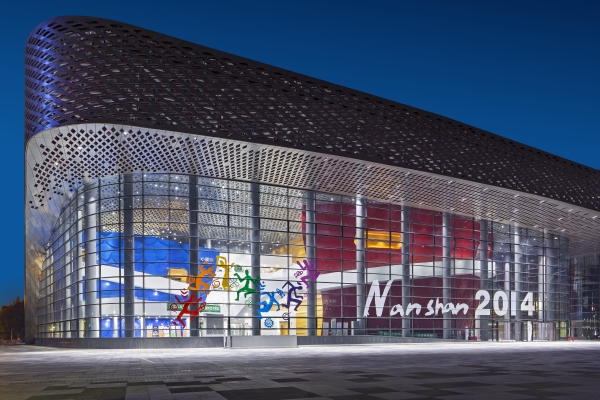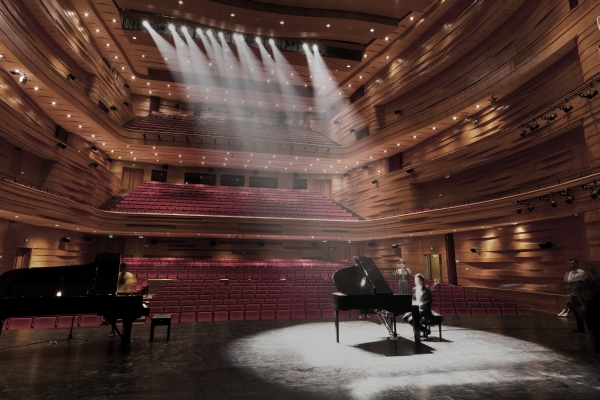A City is Born
Nanshan Cultural and Sports Centre, Art Museum China
Architects: Gábor Zoboki, Nóra Demeter
Text: Anna Zöldi
Photos: Tiani Wei, Zang Chao

A team of Hungarian architects completed a development in China which goes far beyond the most ambitious visions in Hungary owing to its grand scale. Zoboki-Demeter Architects were commissioned to design both the complex housing the cultural and sports centre as well as an art museum in Shenzhen and to work out the concept of the cultural main square. The Chinese clients visited the Arts Palace during their visit in Budapest, and they fell in love with it at first sight, which in turn meant that they wished to see a similar complex in their mother country. As there was a vast cultural complex being built in Shenzen at the time, they invited the architect of this highly attractive model to ask for his advice and then to advance with the project accordingly. This dynamic gesture yielded a similarly dynamic reaction – a result which was a surprise even for them. Gábor Zoboki and Nóra Demeter interpreted this task as a cultural commission. Formerly a fishermen’s village, the city located in the South of China has evolved into a metropolis of 16 million inhabitants within twenty years where the local management stood up for a systematic central urban planning scheme and made a decision to develop a new cultural main square where the dwellers of the rapidly developing city have access to all the facilities needed to spend their free time in the European style: in this modern kind of agora a sports centre, a museum, a theatre and a concert hall are centered to await those wanting to be entertained. The consistent functional approach of Zoboki and their architects swept decision-makers off their feet. To analyse the functions carefully appears to be justified and seems like the only potential architectural approach in a distinctly unfamiliar cultural context. Considering potentials, a different kind of sobriety is the winner: this is why Zoboki and architects were chosen for the project by the Chinese client. It is typical of local conditions that when decision-makers were convinced of the fact that the concept of Hungarian designers is more useful for them, Chinese designers were immediately instructed to adapt the designs made by ZDA architects.

Whilst revising the functions the primary concern was how it is simply possible to create a human-scale and intimate square with fine acoustics in an Asian metropolis of 16 million inhabitants where both the audience and artists feel at home. Hungarian designers convinced the managers of Shenzen to build a complex hall seating 1,400 people instead of an auditorium with general functions and a seating capacity of 1,400 people and to have a multi-functional theatre for children next to the auditorium maximum instead of movie halls. Both rooms are multi-functional which in turn brought about genuine architectural challenges because of the technical solutions included in the scheme. As ZDA firmly believes that the sustainability of an institution does not primarily depend on its “green” operations and maintenance, but also on its planned rational utilization. To make such plans is the responsibility of the architect. The floor of the auditorium in the children’s theatre can be slanted and by removing the seats the hall can be turned into a flat-floor one when it is used for balls, for example, and the concert-shell built in the stage allows to close down the space above the stage. The multi-functional hall is suited to house classic theatre productions, opera, dance and musical performances, classical and pop concerts, as well as congresses or conferences. The variably sinkable system of the stage, mobile concert shells, lateral and back stage, completely automated lower stage contribute to the facilities. The automatic operation of the orchestra pit made it possible to adjust the dimensions of the stage so as to meet current needs: it can even be incorporated totally invisibly to increase the capacity of both the auditorium and the stage. Musical multi-functionality is guaranteed by the acoustically carefully designed facework of the walls and the changeable acoustic parameters of the room. The chief component of the latter is the ceiling divided into six parts the positions of which can be changed and moved independently, besides the fact that the whole expanse of the ceiling is sinkable. The latter is also suited to acoustic harmonization and the dimensions of the hall can be adjusted to meet the parameters of current demands.

This spectacular design thus conceals carefully orchestrated functionality. As such, it is also like a nod to China – winding white ribbons of communicating hallways and passages, a shading system made up of several tens of thousands individual aluminium forms to integrate blocks of various functions under one and the same roof, and the large red and blue masques in the foyer of the cultural centre that evoke those used in traditional Chinese operas. It was a great experience for Hungarian designers that despite the distance of several tens of thousands kilometres everything was built according to plans, including the tiniest details. It is true for the spectacle at least. When it came to the materials used, the Chinese partner tended to choose rational alternatives, which was in turn realized in a characteristically Chinese way that is by upkeeping appearances to the maximum. However, all this is a bonus game after the systematically conceived planning of utilization: spectacular but not the most important component in the procedure. The essence is the success achieved in a totally different cultural context, a new form of communication which means the dedicated application of cultural achievements that both partners regard as essential values and their sensitive adaptation as well as showing a maximum degree of respect to local conditions.
General design: Zoboki-Demeter Építésziroda
Leading architects: Gábor Zoboki, Nóra Demeter
Propject architects: Csaba Silvester, Zoltán Turi, István Országh
Architects: Gábor Szatmári, László Rózsás, János Erőss, Péter Böhler, Nóra Hess, Endre Finta, Csaba Rajnai, Richárd Borzák, László Kakas, Linda Tolnai, Miklós Leits, Béla Reppert, Adrián Savanyú, Krisztián Jancsó, Béla Szokolay, Erik Halmosi, Eszter Kovács
Stage technology: Lőrinc Strack, Zsuzsa Tompai
Acoustics: Federico Cruz Barney – Studio DAP, Paris
Structure: Gábor Földvári – Földvári Mérnökiroda, András Szabó – System Steel Kft.
HVAC: Zsolt Kálmán – Kálmán és Társai Épületgépész Kft., János Bukovics – G&B Plan Kft.
Electrical engineering: Ferenc Rajkai – Hungaroproject Mérnökiroda
Landscape: Zsuzsa Bogner
Project manager: Wu Fang
Client: Nanshan Építési Hivatal
Chinese partner: Zhang Zhenzhou, Ding Wei, Chen Linshang – CCDI, Bao Ying Dan, Mei Xiang Yang – SEDI, X Urban










